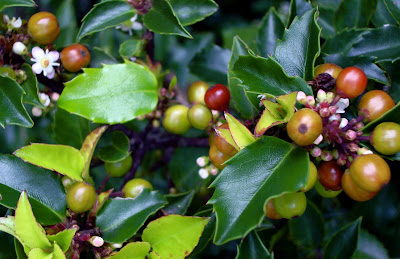As I walked from bush to bush--stopping along the way to sprinkle a few handfuls of fertilizer on a bed of pachysandra or over the lilies of the valley--I realized that this garden contains a lot of plants with berries and that those berries fruit in all colors.

Earlier this year, when the front foundation plantings were renovated, my savvy sister-in-law suggested Ilex meserveae "Blue Princess" and "Blue Prince" for this north-facing elevation. These berries testify to the happy home and compatible relationship these hollies have found.
Nearby grow a couple of black-berried Ilex crenata "Chesapeake." How could a Maryland native not honor a variety named after the Bay? Although maybe this holly would prefer a more southern clime, as it is terribly vulnerable to winter kill and begs for a hard pruning every spring.

Another Japanese holly that fares better is this large, late blooming Heller's variety Ilex crenata hellerii. It is just now sporting tiny creamy flowers.

Some of the first bushes that we planted 15 years ago were American hollies, both red-fruited female Ilex opaca "Christmas Tree" and, for company, a yellow-berried male Ilex opaca, variety forgotten.


Some of my favorite hollies are a pair of sparsely fruiting Ilex opaca. These two American hollies were among six softwood cuttings that my mother took a decade ago from hollies growing freely on my in=laws' Cape Cod property. Glossy, well-formed foliage--but all of three berries!



No comments:
Post a Comment